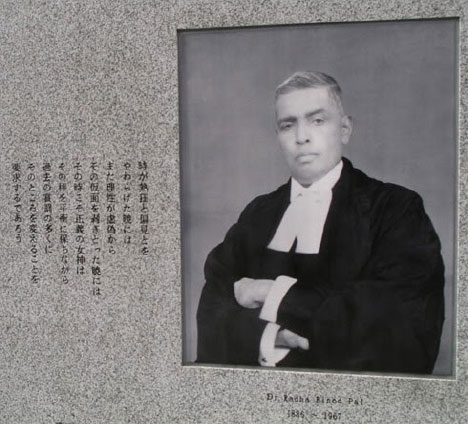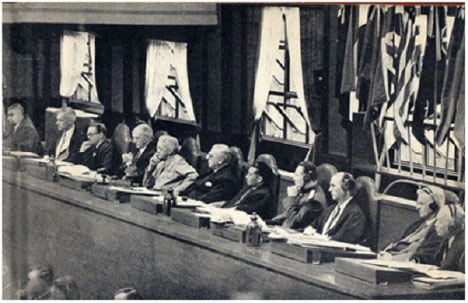JUSTICE RHADHABINOD PAL
By Baba Vickram Aditya Bedi

Justice Rhadhabinod Pal (1886–1967)
Justice Rhadhbinod Pal was awarded the “Order of the Sacred Treasure” by the Emperor of Japan. A Memorial was built for him at the Yasukuni Shrine in Japan which is seen above.
“The principled judgment of Judge Radhabinod Pal after the War is remembered even today in Japan. Ladies and Gentlemen, these events reflect the depth of our friendship and the fact that we have stood by each other at critical moments in our history.” Prime Minister Manmohan Singh, Tokyo Japan at the Diet (Japanese Parliament), December 14, 2006
After World War II was over a War Crimes Trial was convened in the Far East by the Victorious Allies; there were member Judges from the Allied Nations. The British Empire, knowing that India would be undoubtedly freed from it’s occupation of 190 years, within a matter of years, allowed under American Pressure that an Indian Barrister and Judge, Justice Rhadabinod Pal to sit on the International Military Tribunal for the Far East , representing. India. The British Empire would regret almost immediately having his presence there as he simply did not believe in the validity of the process by which the British Empire that had committed grave crimes against humanity in India, could now put on trial an Asian nation, Japan, for actions it had committed in a different form. . For Justice Pal this was a moment he had waited for his whole life. He had seen with his own eyes the incredibly harsh rule of colonialism in India. He had seen Freedom Fighters executed without legal process, and the level of poverty caused by colonial policies. It would seem his opinion was made more rigid by the fact that his native Province of Bengal had just come out of the largest man-made famine of the 20th century, the Bengal Famine. Estimates range from 6–10 million deaths in this single event. The famine had been caused by the policies of the British Colonial Government in India and largely by Winston Churchill, who wanted to “Starve the Indian Freedom Fighters”. Justice Pal was very much a product of his experience and time.
As the trial progressed, Justice Pal would be the only judge who would criticize the use of Atomic Weapons against Japan. He even would go so far as to state that the United States had provoked the War with Japan and waited for it to act. Justice Pal did not however support the fact that no war crimes had been committed by the Empire of Japan, but rather he supported the opinion that the process by which the war began and the now prosecution of Japanese war time leaders was not being done with any semblance of real justice, for it was a process of “Retribution”. His opinion was the lone opinion of “Dissent” in the entire trial. He would state openly in meetings held with other justices that the trial was a “sham employment of legal process for the satisfaction of a thirst for revenge." In his conclusion in the trial he would state “I would hold that every one of the accused must be found not guilty of every one of the charges in the indictment and should be acquitted on all those charges.” For he felt that the War Crimes had been covered by the B and C trials which were in lower courts, and dealt with those who actually were on the ground serving in Japanese Units. This stance still remains controversial and looking back at history this stance would not have been fair to captured Allied Troops nor to Asian nations which suffered under Japanese occupation. But his judgement was not linked to this basis, as he felt nothing could really be done for the loss of life that had happened already. But he could by taking an overly rigid stance change the future course of development for Asia, as he knew colonialism for all of Asia was about to be over.
His standpoint was not followed, and Justice Pal most likely knew it wouldn't be as he realized that Japan had committed serious war crimes. His real intent was to provoke a leniency towards Emperor Hirohito. It was understood that any attempt to apply the Death Penalty against the Japanese Emperor would be not be supported by a unanimous vote because of Justice Pal, and this was not a development the Allies wanted. It was feared Justice Pal would write extensive conclusions, and go into lengthy oratory against this; he had said so openly, that if the Emperor was put on trial then he would respond as such. He was viewed by many in trial as a fanatic who had been recruited from the right wing of the Indian Freedom world.
Even from a truly Neutral perspective, there is no denying that Japan did commit very severe and inhuman war crimes against prisoners of war and occupied populations. There were notorious experiments done by Unit 731, where P.O.Wwere subject to freezing limbs and amputations without anesthesia. After no limbs remained, these victims would then be subject to final death via the use of pathogen experimentation. In actuality this unit’s origin could be traced by direct link to Emperor Hirohito. Thus, he was not free from direct involvement as has become common belief in the years following World War II. For Justice Pal and his experience under British Rule in India, his perception would represent that of a good portion of the Indian Population at that time. Years after the trial, in 1966 while visiting Japan, Justice Pal would state that he had admired Japan from an early age for it had “"stood up against the West”. Indian Freedom fighters such as Shaheed Udham Singh had made such statements at his trial in London in 1940, which he knew he had no chance of winning, and would end with his meeting his creator.
In 1946, India was a nation which saw 2.5 Million soldiers returning from World War II, who had fought for the British Empire. On the other side, Netaji Subhas Chandra Bose’s, Indian National Army returned in utter defeat after fighting the British Empire with Axis’ Support. In Karachi the Indian Navy would mutiny and unfurl the Indian Flag and chant “Karo ya Marau” or “Do it or die”, they no longer cared about dying but wanted an India whose dignity had been trampled upon for 190 years, a nation which had been reduced from the world’s largest economy to a nation which saw it’s own citizens dying on the streets from starvation. Justice Pal embodied all these experiences and he was India’s first voice on an international stage since 1757.
In retrospect, Justice Pal did represent the prevailing view of many in India at this time in history. Justice Pal never did state that no war crimes had been committed by Japan, he only wished to take away the possibility of such a situation arising again. For this he saw the establishment of the Japanese Monarchy as now a support to a democratic revitalization of Japan. He would be awarded numerous honors and citations by the Japanese government and Emperor in the years which followed. His actions would be in large part form a basis for the Modern Relationship that the Republic of India and Japan would develop in the first decades of Indian Independence. In 2005 Japanese Prime Minister Kuzumi would state “"This, Pandit Nehru felt, gave to Japan a proper position of honour and equality among the community of free nations. In that Peace Treaty, India waived all reparation claims against Japan. The dissenting judgement of Judge Radhabinod Pal is well-known to the Japanese people and will always symbolise the affection and regard our people have for your country.” Prime Minister Abe would meet with Justice Pal’s son in 2007 when visiting India.
There are those who wish to negate the role of Justice Pal, and for this there is one fact which is undeniable. The purpose of the International Military Tribunal for the Far East was in no way to spare the Emperor of Japan. The decision to spare him would come about during the trial, as two developments took place. The first was that General Tojo took on a lion share of blame for Japan’s actions in the war. And he pushed the idea that the Emperor of Japan could not have ended the war, this is not supported by history, as no power in Japan would have dared to stop the Emperor, for ultimately it was the Emperor who did end the war. The Second was the atmosphere created by Justice Pal in the court, there was no getting around his 1225 page conclusion nor his issues with the legitimacy of the process. In actuality much of this was not looked upon negatively at the time by the U.S. for it was ultimately understood by them that removing the monarchy was not in their ultimate interest. And here politics were played by them as well. For China was about to become communist, the North Korean Peninsula was another issue and having Japan without it’s Sacred Institution simply would have created a fertile ground for the rise of another military dictatorship or even worse a Communist movement. Thus, Justice Pal was not so far removed as superficially viewed, his voice was needed at the time.
Justice Rhadabinod Pal, is seen by many in India today as a controversial figure, and for many in India he is a figure that they are not familiar with anymore. Yet, in Indian National History, Justice Rhadabinod Pal, did something which cannot be measured by simple historic fact, for he went beyond this through his actions. He still represented a still United India on the world stage, and through his actions, he led to the preservation of the Japanese Monarchy by which Japan would become a Democracy. Justice Pal took the suffering of 60 Million Indians who perished in colonial famines, of those Indians who perished from lack of medicine and denial of even basic human rights, and took this pain and did something positive with it for Asia. For Asia is at peace today, because the preservation of the Japanese Monarchy which led to the development of a state which no longer values warfare and conflict. Sometimes you must look beyond simple facts, and have a vision to plant the seed of sustainable relationships. It was to this great gift of Ancient India, that Justice Pal drew his inspiration, and to this cause that he made his judgement.

Justice Pal and the International Military Tribunal for the Far East.
Sources:
- Experiences with Baba Dr. Dina Nath Bedi
- India a History, John Keay
- Timeline of major famines in India during British rule - Wikipedia
- Churchill’s Secret War and the Ravaging of India and Bengal Famine, Mahdushree Mukerjee
- Radhabinod Pal - Wikipedia